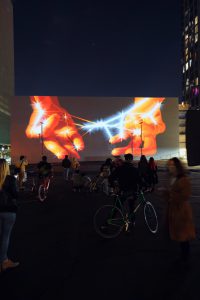NFT stands for non-fungible tokens, meaning you can’t exchange one NFT for another, that run on a blockchain network, which is a digital ledger that records all transactions of cryptocurrencies like bitcoin.
And… what is blockchain technology?
The blockchain can be defined as a system of digital records of transactions that are duplicated and distributed as a network amongst the computer systems on the blockchain.
The blockchain can be simplified as blocks of transactional records that are linked together through the ‘chain’ that are really public databases.
For that reason, this whole system is known as a ‘digital ledger’.

What is the difference between an NFT, a bitcoin and other tokens?
The main difference between an NFT with bitcoin and other tokens, though, is that each NFT is unique and can’t be replicated. Crypto investors affirm that NFTs derive their value from how scarce they are. They’re stored in digital wallets as collectors’ items. Besides art and sports, people have also found uses for NFTs in virtual real estate and gaming.
Everyday more people decide to turn to NFTs to prove ownership of their work and find an additional source of revenue.
According to Nadya Ivanova, chief operating officer of BNP Paribas-affiliated research firm L’atelier – in an interview with CNBC- NFTs are allowing content creators to actually own the property rights for what they create, which allows them to profit from it in different ways which they can’t do with physical art. She also said that crypto art is the strongest growing subsection of the digital collectibles market.

Collectibles, digital art and rare things.
Twitter founder Jack Dorsey sold his first tweet for the equivalent of $2.9 million dollars
NFL star Rob Gronkowski would like for you to purchase his most notable Super Bowl moments.
Recently, Canadian musician and artist Grimes- who is also Elon Musk’s girlfriend- sold her own collection of digital art for over $6 million dollars. The collection consisted of 10 pieces of artwork that included a “one-of-a-kind” video named “Death of the Old” among other pieces.
Another example is the ‘Nyan cat’ gif by Chris Torres that was remastered and sold for $600,000 dollars.
Before non-fungible tokens (NFTs) came along, these statements wouldn’t have made any sense. But now, the digital art and collectibles market have become more and more popular thanks to the blockchain. These NFTs give creators and investors the opportunity to sell and buy exclusively digital objects that range from 3D videos to songs and everything in between.


Why is this trend becoming so popular?
One of the main benefits has to do with the fact that rather than buying a pack of sports cards, bringing them home, and stuffing them into a box to store, it’s easier to pay for a pack of digital cards. The issuer only allows a certain number of people to buy each specific digital card, and the transactions get marked down on an official register which is what we know as a blockchain.
This is how it works for pretty much any digital work. Artists can make videos, photographs, songs, and 3D renderings and then sell a number of official versions to people who want to buy them. The purchasers don’t get a physical product, but what they get instead is the ownership of the digital object on the blockchain record, which is public and uneditable through unofficial channels. They can later sell that ownership to someone else for whatever currency they prefer.
But there’s a catch…
Just because you buy an NFT doesn’t mean you’re the only one who will get to see it.
In fact, someone could easily just go online, find the media included in that NFT you bought, and download it.
It can be anything from a 3D animated video to a drawing made by a famous artist, anyone else who wants to see will be able to do so.
But, according to the blockchain register, you’ll still own it. So, while anyone can see or watch the media in question, only owners will be able to sell their position on it.
The same thing goes for digital artists.
Say an illustrator creates a drawing and then issues 20 official NFT slots associated with it. Only 20 people can then buy the art, which they can turn around and sell as if they had bought a physical painting.
All of the transactions remain visible to everyone via the blockchain.

The importance of Crypto-Art and Digital Collectibles
Due to blockchain technology, NFTs are really gaining popularity everyday.
In the case of crypto art, this is not a new phenomenon. It has been around for a decade but only recently with a more than 400% increase in Bitcoin value has the attention been brought back to digital collectibles.
The total value of the crypto-art market is estimated to be about $80 million to date.
So this is a trend that won’t go away any time soon.

If you want to know more about NFTs, Blockchain and others, contact us. We will be more than happy to help you.
Until next time.

 Co-Founder & CEO @ Inmind - Blockchain & Mobile Expert | DAO / Tokenization / Web3 | CTO @ Brainstems (Former TIEX) | Board Member @ CUTI
Co-Founder & CEO @ Inmind - Blockchain & Mobile Expert | DAO / Tokenization / Web3 | CTO @ Brainstems (Former TIEX) | Board Member @ CUTI